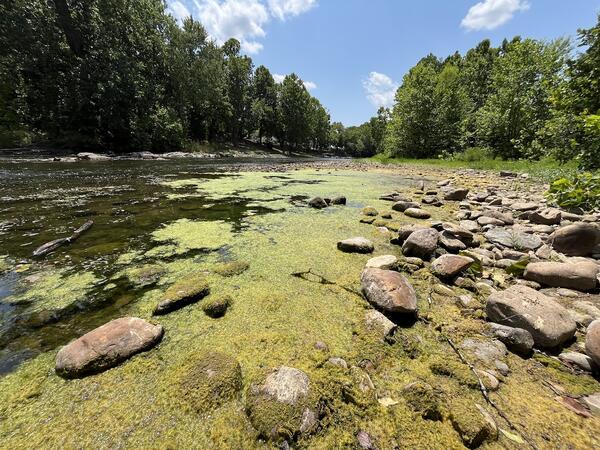South Fork Shenandoah River
Detailed Description
Aerial photograph of the South Fork of the Shenandoah River near Rileyville, Virginia.
Sources/Usage
Photo by Spencer Tassone. This photo is licensed under CC-BY-4.0 (some rights reserved). Used with Permission.
Related
Wastewater reuse may be detrimental to smallmouth bass abundance in the Shenandoah River Watershed
Issue: Municipal and industrial wastewater effluent is an important source of water for streams and rivers, especially during periods of low flow. The reuse of wastewater effluent may become even more important if climate change exacerbates low streamflow and drought conditions. However, wastewater effluent often contains chemicals that, when chronically present, can affect the health of aquatic...
Investigation of Drivers of Harmful Algal Blooms on the Shenandoah River, Virginia
The U.S. Geological Survey (USGS), in cooperation with the Viriginia Department of Environmental Quality (DEQ) and collaboration with the Interstate Commission on the Potomac River Basin (ICPRB) is monitoring harmful algal blooms (HABs) on the two forks of the Shenandoah River in Virginia. Continuous and discrete water-quality and hydrology data is conducted to understand the drivers, persistence...
Shenandoah River Instream Flow Studies
As urban and rural growth continues, competition for clean water expands into stream areas previously capable of meeting local water-use demands. Conflicts among instream and offstream users of streamflow increase as flows decrease. This research enhances understanding of summer low-flow conditions in the North Fork, South Fork, and Shenandoah Rivers, relating water availability to physical...
Shenandoah River South Fork
Shenandoah River South Fork

Storm Debris in the Shenandoah River South Fork after Hurricane Debby

Habitat sampling at Compton Ford on the South Fork Shenandoah River
Related
Wastewater reuse may be detrimental to smallmouth bass abundance in the Shenandoah River Watershed
Issue: Municipal and industrial wastewater effluent is an important source of water for streams and rivers, especially during periods of low flow. The reuse of wastewater effluent may become even more important if climate change exacerbates low streamflow and drought conditions. However, wastewater effluent often contains chemicals that, when chronically present, can affect the health of aquatic...
Investigation of Drivers of Harmful Algal Blooms on the Shenandoah River, Virginia
The U.S. Geological Survey (USGS), in cooperation with the Viriginia Department of Environmental Quality (DEQ) and collaboration with the Interstate Commission on the Potomac River Basin (ICPRB) is monitoring harmful algal blooms (HABs) on the two forks of the Shenandoah River in Virginia. Continuous and discrete water-quality and hydrology data is conducted to understand the drivers, persistence...
Shenandoah River Instream Flow Studies
As urban and rural growth continues, competition for clean water expands into stream areas previously capable of meeting local water-use demands. Conflicts among instream and offstream users of streamflow increase as flows decrease. This research enhances understanding of summer low-flow conditions in the North Fork, South Fork, and Shenandoah Rivers, relating water availability to physical...
Shenandoah River South Fork
Shenandoah River South Fork

Storm Debris in the Shenandoah River South Fork after Hurricane Debby

Habitat sampling at Compton Ford on the South Fork Shenandoah River













